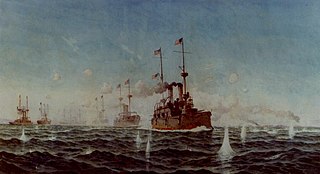
The Battle of Manila Bay, also known as the Battle of Cavite, took place on 1 May 1898, during the Spanish–American War. The American Asiatic Squadron under Commodore George Dewey engaged and destroyed the Spanish Pacific Squadron under Contraalmirante Patricio Montojo. The battle took place in Manila Bay in the Philippines, and was the first major engagement of the Spanish–American War. The battle was one of the most decisive naval battles in history and marked the end of the Spanish colonial period in Philippine history.
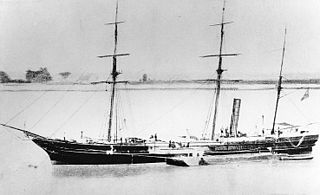
CSS McRae was a Confederate gunboat that saw service during the American Civil War. Displacing around 680 tons, she was armed with one 9-inch (229 mm) smoothbore and six 32-pounder (15 kg) smoothbore cannon.

The Battle of Cárdenas was a minor naval engagement of the Spanish–American War fought on 11 May 1898 in the port of Cárdenas, Cuba, between an American squadron of 5 ships under Captain Chapman C. Todd and 3 small Spanish vessels under Mariano Mateu. The battle resulted in an unusually costly American reverse that dissuaded the U.S. Navy from undertaking further attacks on the port.

The third USS Preble was a Bainbridge-class destroyer in commission in the United States Navy from 1903 to 1919. She was named for Commodore Edward Preble. She saw service in World War I.

CSSSelma was a steamship in the Confederate States Navy during the American Civil War. She served in the Confederate Navy first as Florida, and later as Selma. She was captured by the Union Navy steamer USS Metacomet during the Battle of Mobile Bay. She served as USS Selma until the end of the war, when she was decommissioned and sold for use as a merchant ship.

USS Varuna was a screw steamer acquired by the Union Navy during the American Civil War. Under construction in 1861, she was purchased incomplete on 31 December. After being commissioned in February 1862, she traveled to join the West Gulf Blockading Squadron. Varuna was present when Flag Officer David Glasgow Farragut led an attack against Confederate positions at Fort Jackson and Fort St. Philip on 24 April. During the action, Varuna ran ahead of the other Union ships, and was engaged in a chase with the Louisiana gunboat Governor Moore. After closing in on the Union ship, Governor Moore rammed Varuna twice, with the gunboat CSS Stonewall Jackson adding a third blow. Varuna sank within 15 minutes, but Farragut was able to capture the city of New Orleans, Louisiana.

The sixth USS Hornet was a gunboat in the United States Navy. Hornet, the former yacht Alicia, was built by Harlan and Hollingsworth, Wilmington, Delaware, in 1890; purchased from Henry Morrison Flagler on 6 April 1898; and commissioned at New York 12 April 1898, Lieutenant James Meredith Helm in command.

Laurent Millaudon was a wooden side-wheel river steamboat launched at Cincinnati, Ohio, in 1856 operating in the New Orleans, Louisiana, area, and captained by W. S. Whann. At the beginning of the American Civil War she was taken into service by the Confederate Navy as CSS General Sterling Price. On 6 June 1862, she was sunk at the Battle of Memphis. She was raised and repaired by the Union army, and on 16 June 1862 was moved into Union service as USS General Price and served until the end of the war.
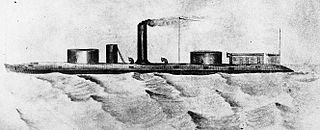
USS Winnebago was a double-turret Milwaukee-class river monitor, named for the Winnebago tribe of Siouan Indians, built for the Union Navy during the American Civil War. The ship participated in the Battle of Mobile Bay in 1864, during which she was lightly damaged, and the bombardments of Forts Gaines and Morgan as Union troops besieged the fortifications defending the bay. In early 1865, Winnebago again supported Union forces during the Mobile Campaign as they attacked Confederate fortifications defending the city of Mobile, Alabama. She was placed in reserve after the end of the war and sold in 1874.

USS Manhattan was a single-turreted Canonicus-class monitor built for the Union Navy during the American Civil War. After commissioning in 1864 the ship was assigned to the West Gulf Blockading Squadron and participated in the Battle of Mobile Bay. At the end of the battle, Manhattan took the surrender of the Confederate casemate ironclad ram Tennessee. She bombarded Fort Morgan during the Siege of Fort Morgan and later blockaded the mouth of the Red River until the end of the war.

The Battle of Forts Jackson and St. Philip was the decisive battle for possession of New Orleans in the American Civil War. The two Confederate forts on the Mississippi River south of the city were attacked by a Union Navy fleet. As long as the forts could keep the Federal forces from moving on the city, it was safe, but if they fell or were bypassed, there were no fall-back positions to impede the Union advance.
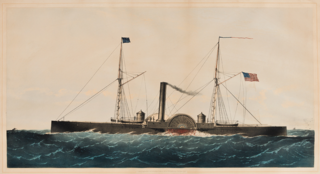
USS Osceola was a wooden, sidewheel Sassacus-class gunboat which saw combat with the Union Navy in the American Civil War. She was designed with shallow draft and double-ends specifically to allow her to operate in the narrow rivers and inlets along the Confederate coast. She was well suited to this role and took part in major battles on the James and Cape Fear Rivers.
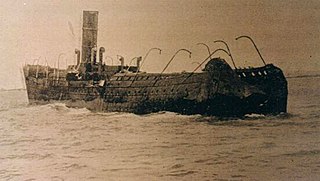
The Third Battle of San Juan began on 28 June 1898 when an American auxiliary cruiser intercepted a Spanish blockade runner. A Spanish squadron attempted to rescue the blockade runner and succeeded in taking off supplies and her crew but failed to save the ship, which the American warship engaged and forced to run aground.

The First Battle of Topolobampo was a bloodless engagement and one of the few naval battles of the Mexican Revolution. The small action occurred off Topolobampo, Mexico and involved three gunboats, two from the Mexican Navy and another which mutinied from the armada and joined the rebel Constitutionalists. It was fought on the morning of March 4, 1914 and was the first battle of the naval campaign in the Gulf of California.

The Second Battle of Topolobampo was a bloodless naval engagement during the Mexican Revolution. In March 1914, a rebel Constitutionalist gunboat attempted to break the blockade of Topolobampo, Sinaloa in Mexico. The attack forced federal gunboats to a further distance but failed to lift the blockade.

The Fourth Battle of Topolobampo was a single ship action fought during the Mexican Revolution and the last naval battle of the Topolobampo Campaign. In June 1914, a Huertista gunboat sank a Constitutionalist gunboat off Topolobampo, Sinaloa in the Gulf of California.

The Battle of the Head of Passes was a bloodless naval battle of the American Civil War. It was a naval raid made by the Confederate river defense fleet, also known as the “mosquito fleet” in the local media, on ships of the Union blockade squadron anchored at the Head of Passes. The mosquito fleet deployed three fire rafts, which were ignited and followed the ironclad ram CSS Manassas into the action. The attack occurred after moonset in the early hours of October 12, 1861, and routed the Union fleet, which fled in disorder down the Southwest pass of the delta. After sunrise Commodore George N. Hollins, running low on ammunition and fuel, ordered the mosquito fleet to withdraw upriver.

The First Battle of Cárdenas was a naval action fought in May 1898 during the Spanish–American War. A force of three Spanish vessels attempted to lift the blockade of Cárdenas but were repulsed and sent back into harbor by two United States Navy warships.

The action of 13 June 1898 was a minor naval engagement of the Spanish–American War fought near Cienfuegos, Cuba, between the American auxiliary cruiser USS Yankee under Commander Willard Herbert Brownson and the Spanish gunboat Diego Velázquez under Teniente de Navío de 1ª clase Juan de Carranza, which had exited the port to inspect a suspicious steamer which proved to be Yankee. Diego Velázquez, markedly inferior to Yankee in armament, managed to return to Cienfuegos, where it was joined by the small gunboats Lince and Cometa. After the appearance of the latters, Yankee decided to withdraw.

USS Wompatuck (YT-27) was an armed tug in commission in the United States Navy from 1898 to 1931. Early in her naval career, she saw combat in the Spanish–American War and the Philippine–American War. After she was decommissioned, she was selected for conversion into the fuel oil barge YO-64, but she was lost in the early days of World War II in the Pacific before the conversion could be completed.




















